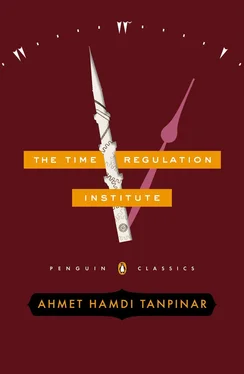By the time we had agreed on all these details it was midnight. It was not without trepidation that I asked my son:
“Do you realize what time it is?”
“No, I don’t,” he replied. “What’s so important about it?”
“It’s the hour of your birth…”
Suddenly he blushed and smiled. It was clear that he was pleased. But then he furrowed his brow and looked down at his feet. I understood from this that he was afraid I might be hurt by what he had to say, but he couldn’t keep quiet for very long.
“Father,” he said. “There’s no need to be overly sentimental. We’re not yet at the point where we’d give up on each other over a difference in opinion. And I speak for all of us. But I do feel much more comfortable with how we are now.”
Perhaps it was the fear I felt hearing these words that led me to ask what was missing in the design. What was I going to do with this 720-square-meter central hall? All night I racked my brains. Toward dawn I hit upon the idea of dividing the space with a balustrade like the one from the cemetery of the Kahvecibası Mosque that I still kept at home — then at least the hall would not seem quite so vast on first seeing it. But this wasn’t enough. I needed something else to break up the space. I was flipping through one of the architecture magazines that Ahmet had borrowed from his classmates, when I chanced upon a few pictures that suggested the perfect solution. Halfway along the balustrade I would erect four large columns — as large as those enormous funnels that one saw on oil tankers facing north, east, south and west. But the hall’s glass roof had no need of such pillars. Then came my moment of sublime inspiration. If we had to have pillars, then we would also have to have a second floor. A second floor would appear to reflect the Time Regulation Institute’s very essence. We had founded the institute to generate employment for ourselves, and now, having created pillars to soften the look of the vast hall, we would give those pillars a purpose. In the early hours of the morning I was struck by the idea that allowed me to perfect the hall’s composition. The four pillars would stand in a row with a passageway running through them. To go from the right to the left side of the hall, you would pass first through the door in the Morning Pillar; then passing through the door in the Afternoon Pillar, you would climb the stairs inside the Evening Pillar; and when you at last descended through the Night Pillar, you found yourself on the other side of the hall. A visitor wishing to cross from the right side of the hall to the left would pass through Night, Evening, and Afternoon before finally exiting through the latticed door of the Morning Pillar.
After consulting Ahmet over breakfast, I was able to crystallize my idea. Ahmet reminded me of the minarets on the Üç Serefeli Mosque. Everyone knows how the muezzins at Üç Serefeli walk up three separated sets of stairs without ever seeing one another. Our pillars would achieve the precise opposite.
People moving up and down either wrought-copper staircase would be visible, as they would be encased in glass. I now saw I could arrange them diagonally across the center of the hall to disrupt the traditional four leaf clover formation. Of course all the pillars — each one a little higher than the next — would be connected by little bridges so as to allow those moving up and down them to cross.
So far so good. But I still felt uneasy about the upper-floor lounge. Far from solving our original problem, the pillars and the balustrade had resulted in our transferring it to the upper floor. Once again past experience, or really something I had picked up from all those newspapers I’d read out of boredom in the coffeehouse during the years I was unemployed, came to my rescue. Rather than create another hall, why not a roof garden of the type seen on skyscrapers? After settling on the garden, I realized I could illuminate the hall with natural light by putting a glass roof over the top of the columns and running two long, thick panes of glass along the full length of the courtyard. True, we would already have ample gardens around the building and most skyscraper gardens are on the thirtieth floor and higher, but at least our friends would be able to see a few flowers when they took a break from work, and if nothing else second-floor windows overlooking the courtyard would let in some natural light. I decided to landscape the garden in the shape of a clock, just as I had done with the garden at the front gate and the one located at the six o’clock pavilion. There would be just one difference — the roof garden would be adorned with a bust of Ahmet Zamanı. Thus our hall would be a fusion of both the traditional and the modern. Indeed this hall went on to become our crowning achievement.
I determined that only four of our pavilions would have more than one floor. The front pavilion with its large gate represented twelve o’clock, while its two neighboring pavilions, representing one and eleven o’clock, respectively, would have two floors each. Then I envisioned the twelve o’clock pavilion’s counterpart, the six o’clock pavilion, with three floors. I left the first floor of this pavilion open and undivided, just one large room graced by two broad windows that let in light from both sides. Having designed the second floor as two overlapping circles, I thought it only natural to divide the top floor into separate rooms as in the other pavilions. But instead of designing internal stairs leading from one floor to the next, I arranged for the stairs leading up to the second floor to come from the five o’clock pavilion, with those leading up to the third floor originating from the seven o’clock pavilion. Thus two sets of stairs encased in glass — one relatively shorter than the other, which was less direct — connected the six o’clock pavilion to its neighboring pavilions. And its ground floor was linked directly to the main hall.
In time these rather architecturally redundant innovations — created as an homage to Dr. Mussak, though perhaps I had in mind the allegorical house that my dear friend Dr. Ramiz had used to explain the workings of the human mind and its subconscious when I was undergoing psychoanalysis — became as celebrated as the pillars I’d designed for the main hall; and as I mentioned earlier I was made an honorary member of the International Society of Architects and was even awarded some of its medals, and if my memory serves me, I was in fact awarded medals from two different foreign governments.
Needless to say, the first floor of the six o’clock pavilion was to be our conference room. And the smaller rooms of overlapping circles on the floor above would be used for smaller meetings. The top floor was reserved for Sabriye Hanım, as a tribute to her complex involvement with the public. Indeed there was no other way to free ourselves of our friend’s relentless curiosity or her determination to subject all our affairs to needless scrutiny.
It should come as no surprise that I designed the overlapping circular rooms on the second floor to represent a clock’s inner wheels and cogs. I also designed the large round room in the four o’clock pavilion to suggest the minute hand on the face of a clock. So in the end I paid the full price for my addendum of the words “inside and out” to the competition conditions — this despite the fact that I had added these words only to challenge Halit Ayarcı and force him into an awkward situation, only to be forced to invent a compendium of absurd architectural innovations to suggest the inside and outside of a clock.
The only good thing that came out of all this was the time I got to spend with my son, Ahmet. I had truly missed having my son in my life. And so I was sad as our collaboration came to a close. We were destined to live apart. Ahmet loved me dearly but detested the way I lived and the work I was doing. We spent our last night together in front of the strange models we’d constructed out of hundreds of matchboxes, thinking of Dr. Mussak. We were making the final changes.
Читать дальше












